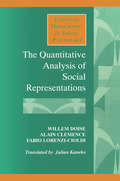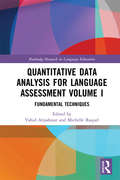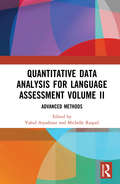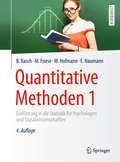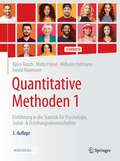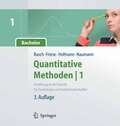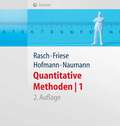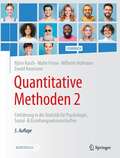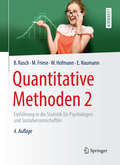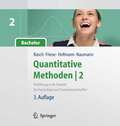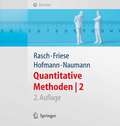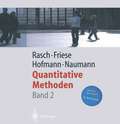- Table View
- List View
Quantified Storytelling: A Narrative Analysis of Metrics on Social Media
by Alex Georgakopoulou Stefan Iversen Carsten StageThis book interrogates the role of quantification in stories on social media: how do visible numbers (e.g. of views, shares, likes) and invisible algorithmic measurements shape the stories we post and engage with? The links of quantification with stories have not been explored sufficiently in storytelling research or in social media studies, despite the fact that platforms have been integrating sophisticated metrics into developing facilities for sharing stories, with a massive appeal to ordinary users, influencers and businesses alike. With case-studies from Instagram, Reddit and Snapchat, the authors show how three types of metrics, namely content metrics, interface metrics and algorithmic metrics, affect the ways in which cancer patients share their experiences, the circulation of specific stories that mobilize counter-publics and the design of stories as facilities on platforms. The analyses document how numbers structure elements in stories, indicate and produce engagement and become resources for the tellers’ self-presentation. This book will be of interest to students and scholars working in the fields of narrative and social media studies, including narratology, biography studies, digital storytelling, life-writing, narrative psychology, sociological approaches to narrative, discourse and sociolinguistic perspectives.
Quantifying Consciousness: An Empirical Approach (Emotions, Personality, and Psychotherapy)
by R.J. PekalaThis book presents an approach to quantifying consciousness and its various states. It represents over ten years of work in developing, test ing, and researching the use of relatively simple self-report question naires in the retrospective assessment of subjective or phenomenologi cal experience. While the simplicity of the method allows for subjective experience to be reliably and validly assessed across various short stim ulus conditions, the flexibility of the approach allows the cognitive psy chologist, consciousness researcher, and mental health professional to quantify and statistically assess the phenomenological variables associ ated with various stimulus conditions, altered-state induction tech niques, and clinical procedures. The methodology allows the cognitive psychologist and mental health professional to comprehensively quantify the structures and pat terns of subjective experience dealing with imagery, attention, affect, volitional control, internal dialogue, and so forth to determine how these phenomenological structures might covary during such stimulus conditions as free association, a sexual fantasy, creative problem solving, or a panic attack. It allows for various phenomenological pro cesses to be reported, quantified, and statistically assessed in a rather comprehensive fashion that should help shed greater understanding on the nature of mind or consciousness.
The Quantitative Analysis of Social Representations (European Monographs in Social Psychology)
by Alain Clemence Willem Doise Fabio Lorenzi-CioldiFirst Published in 1995. Routledge is an imprint of Taylor & Francis, an informa company.
The Quantitative Analysis of Social Representations (European Monographs in Social Psychology)
by Alain Clemence Willem Doise Fabio Lorenzi-CioldiFirst Published in 1995. Routledge is an imprint of Taylor & Francis, an informa company.
Quantitative and Qualitative Methods in Psychotherapy Research (Explorations in Mental Health)
by Wolfgang Lutz Sarah KnoxIn this collection, international contributors come together to discuss how qualitative and quantitative methods can be used in psychotherapy research. The book considers the advantages and disadvantages of each approach, and recognises how each method can enhance our understanding of psychotherapy. Divided into two parts, the book begins with an examination of quantitative research and discusses how we can transfer observations into numbers and statistical findings. Chapters on quantitative methods cover the development of new findings and the improvement of existing findings, identifying and analysing change, and using meta-analysis. The second half of the book comprises chapters considering how qualitative and mixed methods can be used in psychotherapy research. Chapters on qualitative and mixed methods identify various ways to strengthen the trustworthiness of qualitative findings via rigorous data collection and analysis techniques. Adapted from a special issue of Psychotherapy Research, this volume will be key reading for researchers, academics, and professionals who want a greater understanding of how a particular area of research methods can be used in psychotherapy.
Quantitative and Qualitative Methods in Psychotherapy Research (Explorations in Mental Health)
by Wolfgang Lutz Sarah KnoxIn this collection, international contributors come together to discuss how qualitative and quantitative methods can be used in psychotherapy research. The book considers the advantages and disadvantages of each approach, and recognises how each method can enhance our understanding of psychotherapy. Divided into two parts, the book begins with an examination of quantitative research and discusses how we can transfer observations into numbers and statistical findings. Chapters on quantitative methods cover the development of new findings and the improvement of existing findings, identifying and analysing change, and using meta-analysis. The second half of the book comprises chapters considering how qualitative and mixed methods can be used in psychotherapy research. Chapters on qualitative and mixed methods identify various ways to strengthen the trustworthiness of qualitative findings via rigorous data collection and analysis techniques. Adapted from a special issue of Psychotherapy Research, this volume will be key reading for researchers, academics, and professionals who want a greater understanding of how a particular area of research methods can be used in psychotherapy.
Quantitative Assessment in Epilepsy Care (Nato Science Series A: #255)
by Harry Meinardi Joyce A. Cramer Gus A. Baker Antonio Martins Da SilvaAdvances in epilepsy in recent decades have allowed for improved algorithms for diagnosis and a common understanding of terminology with the development of the International Classifications of Seizures and the Epilepsies. Nevertheless, no common system exists for the estimation of epilepsy severity or its impact on quality of life. Therefore, epileptologists lack the ability to make quantitative assessments of individual patients for comparison of care or for meta-analyses in clinical trials. This book on the Quantitative Assessment of Epilepsy Care approaches this omission by addressing the potential application of clinimetrics within the framework of epilepsy treatment. Clinimetrics is a fast growing discipline concerned with the quantification of clinical symptoms with respect to decision making relating to diagnosis, treatment, and prognosis. These methods allow for the development and validation of clinical scoring systems. For example, the Glasgow Coma Scale is widely used. As a chronic disorder, epilepsy would benefit from clinimetric methodology to create uniformity and to allow for comparisons among evaluations. In addition, epileptologists have not yet developed assessments of health related quality of life to define the overall condition of the chronic epilepsy patient and various therapeutic endpoints. While clini metric tools are essential for research, they will also be useful in clinical practice for the care of individual patients by documenting status and changes over time. This treatise will provide critical analyses of whether existing rating scales and techniques are valid to use, and which types of scales and techniques require further development.
Quantitative Data Analysis for Language Assessment Volume I: Fundamental Techniques (Routledge Research in Language Education)
by Vahid Aryadoust Michelle RaquelQuantitative Data Analysis for Language Assessment Volume I: Fundamental Techniques is a resource book that presents the most fundamental techniques of quantitative data analysis in the field of language assessment. Each chapter provides an accessible explanation of the selected technique, a review of language assessment studies that have used the technique, and finally, an example of an authentic study that uses the technique. Readers also get a taste of how to apply each technique through the help of supplementary online resources that include sample data sets and guided instructions. Language assessment students, test designers, and researchers should find this a unique reference as it consolidates theory and application of quantitative data analysis in language assessment.
Quantitative Data Analysis for Language Assessment Volume I: Fundamental Techniques (Routledge Research in Language Education)
by Vahid Aryadoust Michelle RaquelQuantitative Data Analysis for Language Assessment Volume I: Fundamental Techniques is a resource book that presents the most fundamental techniques of quantitative data analysis in the field of language assessment. Each chapter provides an accessible explanation of the selected technique, a review of language assessment studies that have used the technique, and finally, an example of an authentic study that uses the technique. Readers also get a taste of how to apply each technique through the help of supplementary online resources that include sample data sets and guided instructions. Language assessment students, test designers, and researchers should find this a unique reference as it consolidates theory and application of quantitative data analysis in language assessment.
Quantitative Data Analysis for Language Assessment Volume II: Advanced Methods
by Vahid Aryadoust Michelle RaquelQuantitative Data Analysis for Language Assessment Volume II: Advanced Methods demonstrates advanced quantitative techniques for language assessment. The volume takes an interdisciplinary approach and taps into expertise from language assessment, data mining, and psychometrics. The techniques covered include Structural Equation Modeling, Data Mining, Multidimensional Psychometrics and Multilevel Data Analysis.Volume II is distinct among available books in language assessment, as it engages the readers in both theory and application of the methods and introduces relevant techniques for theory construction and validation. This book is highly recommended to graduate students and researchers who are searching for innovative and rigorous approaches and methods to achieve excellence in their dissertations and research. It is also a valuable source for academics who teach quantitative approaches in language assessment and data analysis courses.
Quantitative Data Analysis for Language Assessment Volume II: Advanced Methods
by Vahid Aryadoust Michelle RaquelQuantitative Data Analysis for Language Assessment Volume II: Advanced Methods demonstrates advanced quantitative techniques for language assessment. The volume takes an interdisciplinary approach and taps into expertise from language assessment, data mining, and psychometrics. The techniques covered include Structural Equation Modeling, Data Mining, Multidimensional Psychometrics and Multilevel Data Analysis.Volume II is distinct among available books in language assessment, as it engages the readers in both theory and application of the methods and introduces relevant techniques for theory construction and validation. This book is highly recommended to graduate students and researchers who are searching for innovative and rigorous approaches and methods to achieve excellence in their dissertations and research. It is also a valuable source for academics who teach quantitative approaches in language assessment and data analysis courses.
Quantitative Data Analysis with Minitab: A Guide for Social Scientists
by Alan Bryman Duncan CramerQuantitative data analysis is now a compulsory component of most degree courses in the social sciences and students are increasingly reliant on computers for the analysis of data. Quantitative Data Analysis with Minitab explains statistical tests for Minitab users using the same formulae free, non technical approach, as the very successful SPPS version.Students will learn a wide range of quantitative data analysis techniques and become familiar with how these techniques can be implemented through the latest version of Minitab. Techniques covered include univariate analysis (with frequency table, dispersion and histograms), bivariate (with contingency tables correlation, analysis of varience and non-parametric tests) and multivariate analysis (with multiple regression, path analysis, covarience and factor analysis). In addition the book covers issues such as sampling, statistical significance, conceptualisation and measurement and the selection of appropriate tests. Each chapter concludes with a set of exercises.Social science students will welcome this integrated, non mathematical introduction to quantitative data anlysis and the minitab package.
Quantitative Data Analysis with Minitab: A Guide for Social Scientists
by Alan Bryman Duncan CramerQuantitative data analysis is now a compulsory component of most degree courses in the social sciences and students are increasingly reliant on computers for the analysis of data. Quantitative Data Analysis with Minitab explains statistical tests for Minitab users using the same formulae free, non technical approach, as the very successful SPPS version.Students will learn a wide range of quantitative data analysis techniques and become familiar with how these techniques can be implemented through the latest version of Minitab. Techniques covered include univariate analysis (with frequency table, dispersion and histograms), bivariate (with contingency tables correlation, analysis of varience and non-parametric tests) and multivariate analysis (with multiple regression, path analysis, covarience and factor analysis). In addition the book covers issues such as sampling, statistical significance, conceptualisation and measurement and the selection of appropriate tests. Each chapter concludes with a set of exercises.Social science students will welcome this integrated, non mathematical introduction to quantitative data anlysis and the minitab package.
Quantitative EEG, Event-Related Potentials and Neurotherapy
by Juri D. KropotovWhile the brain is ruled to a large extent by chemical neurotransmitters, it is also a bioelectric organ. The collective study of Quantitative ElectroEncephaloGraphs (QEEG-the conversion of brainwaves to digital form to allow for comparison between neurologically normative and dysfunctional individuals), Event Related Potentials (ERPs - electrophysiological response to stimulus) and Neurotherapy (the process of actually retraining brain processes to) offers a window into brain physiology and function via computer and statistical analyses of traditional EEG patterns, suggesting innovative approaches to the improvement of attention, anxiety, mood and behavior.The volume provides detailed description of the various EEG rhythms and ERPs, the conventional analytic methods such as spectral analysis, and the emerging method utilizing QEEG and ERPs. This research is then related back to practice and all existing approaches in the field of Neurotherapy - conventional EEG-based neurofeedback, brain-computer interface, transcranial Direct Current Stimulation, and Transcranial Magnetic Stimulation - are covered in full. While it does not offer the breadth provided by an edited work, this volume does provide a level of depth and detail that a single author can deliver, as well as giving readers insight into the personl theories of one of the preeminent leaders in the field. - Provide a holistic picture of quantitative EEG and event related potentials as a unified scientific field - Present a unified description of the methods of quantitative EEG and event related potentials - Give a scientifically based overview of existing approaches in the field of neurotherapy - Provide practical information for the better understanding and treatment of disorders, such as ADHD, Schizophrenia, Addiction, OCD, Depression, and Alzheimer's Disease
Quantitative Methoden 1: Einführung in die Statistik für Psychologen und Sozialwissenschaftler (Springer-Lehrbuch)
by Wilhelm Hofmann Björn Rasch Malte Friese Ewald NaumannWelche Angst plagt die meisten Studienanfänger im Psychologie-Studium? Die Angst vor der Statistik-Prüfung! Hier schaffen wir Abhilfe, denn die Statistik ist ein wichtiges Handwerkszeug, um zu verstehen, wie die Psychologie Erkenntnisse gewinnt und ihre Forschungsergebnisse zu bewerten sind – und wenn die Statistik verständlich erklärt ist, gibt es keinen Grund zur Panik! Mit den beiden Bänden Quantitative Methoden 1/2 meistern Sie die Grundlagen der Statistik! Anwendungsbezogen und verständlich werden hier die Inhalte der Vorlesungen Quantitative Methoden, Statistik oder Methodenlehre erklärt. Band 1 umfasst die Themen deskriptive Statistik, Grundzüge der Inferenzstatistik und den t-Test sowie Zusammenhangsmaße und Regression. Mit Verständnisfragen und Antworten, Glossar der wichtigsten Statistik-Begriffe und Verteilungstabellen. – Außerdem mit vielen kostenlosen Zusatzmaterialien auf der begleitenden Lehrbuch-Website: Mehrere hundert Extraseiten mit Anleitungen zur konkreten Durchführung der behandelten statistischen Verfahren mit SPSS und R, Informationen zur Durchführung von Teststärkeanalysen und Stichprobenumfangsplanungen mit G*Power sowie Beispielaufgaben – alles inklusive notwendiger Datensätze. Und ganz NEU in der 4. Auflage: Zahlreiche Erklärungsvideos zu wichtigen Formeln und Zusammenhängen!
Quantitative Methoden 1: Einführung in die Statistik für Psychologie, Sozial- & Erziehungswissenschaften
by Björn Rasch Malte Friese Wilhelm Hofmann Ewald NaumannDieses Lehrbuch macht Dich fit für die Statistik-Prüfung – hier geht es um die Deskriptive Statistik sowie um die ersten Schritte in Inferenzstatistik, z.B. den t-Test. Also Dinge, die in vielen sozialwissenschaftlichen Studiengängen, wie z.B. Psychologie, Soziologie oder Erziehungswissenschaften, auf dem Lehrplan stehen. Vielen macht die Statistik Angst – aber mit diesem Buch wirst Du die Prüfung meistern, weil Dir hier alles sehr verständlich und ergänzt durch kostenfreie Videos und umfangreiche zusätzliche Materialien erklärt wird.
Quantitative Methoden 1.Einführung in die Statistik für Psychologen und Sozialwissenschaftler (Springer-Lehrbuch)
by Björn Rasch Malte Friese Wilhelm Johann Hofmann Ewald NaumannKeine Angst vor Statistik! Welche Angst plagt die meisten Studienanfänger im Psychologie-Studium oder anderen sozialwissenschaftlichen Studiengängen? Die Angst vor der Statistik-Prüfung! Wir schaffen Abhilfe – denn die Statistik ist ein wichtiges Handwerkszeug, um zu verstehen, wie die Psychologie Erkenntnisse gewinnt und wie ihre Forschungsergebnisse zu bewerten sind. Die beiden Bände Quantitative Methoden 1/2 erklären die Inhalte der Statistik-Vorlesungen, d.h. die Methoden der deskriptiven und Inferenzstatistik, einfach und verständlich: Das Buch beginnt wirklich "bei Null", denn die Autoren waren zum Zeitpunkt der ersten Auflage selbst Studenten, d.h. sie wissen, worauf es ankommt. Nun - als Dozenten in der Lehre - haben Sie das einfache Konzept beibehalten, aber einige Fehler eliminiert. Die Bände bieten nützliche Features zum Lernen: Anhand von Prüfungsaufgaben können Sie in jedem Kapitel das erworbene Wissen überprüfen, die Lösungen gibt es natürlich auch dazu. Ein Glossar erklärt die wichtigsten Statistik-Begriffe, Verteilungstabellen helfen beim Durchführen der Tests. NEU ist das ausführliche Stichwortverzeichnis sowie noch ausführlichere Anleitungen (rund 200 Seiten) zur Durchführung der statistischen Verfahren mit SPSS oder GPower zum Download auf der Begleitwebsite.
Quantitative Methoden 1.Einführung in die Statistik für Psychologen und Sozialwissenschaftler
by Björn Rasch Malte Friese Wilhelm Johann Hofmann Ewald NaumannKeine Angst vor Statistik! Sie ist ein wichtiges Handwerkszeug, um zu verstehen, wie die Psychologie Erkenntnisse gewinnt und ihre Forschungsergebnisse zu bewerten sind. Die Grundlagen dazu, vermittelt die Vorlesung Quantitative Methoden, Statistik oder Methodenlehre. Mit den beiden Bänden Quantitative Methoden 1/2 meistern Sie diesen Abschnitt des Psychologie-Studiums. Anwendungsbezogen und verständlich erläutern sie die Inhalte - von Studenten für Studenten. Anhand von Prüfungsaufgaben überprüfen Sie in jedem Kapitel das erworbene Wissen. Selbstverständlich mit Lösungen, Glossar der wichtigsten Statistik-Begriffe und Verteilungstabellen.
Quantitative Methoden 2: Einführung in die Statistik für Psychologie, Sozial- & Erziehungswissenschaften
by Wilhelm Hofmann Björn Rasch Malte Friese Ewald NaumannDieses Lehrbuch macht Dich fit für die Statistik-Prüfung – hier geht es u.a. um Varianzanalysen und Verfahren für Rang- und Nominaldaten. Also Dinge, die in vielen sozialwissenschaftlichen Studiengängen, wie z.B. Psychologie, Soziologie oder Erziehungswissenschaften, auf dem Lehrplan stehen. Mit diesem Buch wirst Du die Prüfung meistern, weil Dir hier alles sehr verständlich und ergänzt durch kostenfreie Videos und umfangreiche zusätzliche Materialien erklärt wird.
Quantitative Methoden 2: Einführung in die Statistik für Psychologen und Sozialwissenschaftler (Springer-Lehrbuch)
by Björn Rasch Malte Friese Wilhelm Hofmann Ewald NaumannWelche Angst plagt die meisten Studienanfänger im Psychologie-Studium? Die Angst vor der Statistik-Prüfung! Hier schaffen wir Abhilfe, denn die Statistik ist ein wichtiges Handwerkszeug, um zu verstehen, wie die Psychologie Erkenntnisse gewinnt und ihre Forschungsergebnisse zu bewerten sind – und wenn die Statistik verständlich erklärt ist, gibt es keinen Grund zur Panik! Mit den beiden Bänden Quantitative Methoden 1/2 meistern Sie die Grundlagen der Statistik! Anwendungsbezogen und verständlich werden hier die Inhalte der Vorlesungen Quantitative Methoden, Statistik oder Methodenlehre erklärt. In Band 2 dreht sich alles rund um die Varianzanalyse (ein-/zweifaktorielle, mit Messwiederholung) sowie zu Verfahren für Rang- bzw. Nominaldaten. Mit Verständnisfragen und Antworten, Glossar der wichtigsten Statistik-Begriffe und Verteilungstabellen. – Außerdem mit vielen kostenlosen Zusatzmaterialien auf der begleitenden Lehrbuch-Website: Mehrere hundert Extraseiten mit Anleitungen zur konkreten Durchführung der behandelten statistischen Verfahren mit SPSS und R, Informationen zur Durchführung von Teststärkeanalysen und Stichprobenumfangsplanungen mit G*Power sowie Beispielaufgaben – alles inklusive notwendiger Datensätze. Und ganz NEU in der 4. Auflage: Zahlreiche Erklärungsvideos zu wichtigen Formeln und Zusammenhängen!
Quantitative Methoden 2. Einführung in die Statistik für Psychologen und Sozialwissenschaftler: Einführung In Die Statistik Für Psychologen Und Sozialwissenschaftler (Springer-Lehrbuch)
by Björn Rasch Malte Friese Wilhelm Johann Hofmann Ewald NaumannKeine Angst vor Statistik! Welche Angst plagt die meisten Studienanfänger im Psychologie-Studium oder anderen sozialwissenschaftlichen Studiengängen? Die Angst vor der Statistik-Prüfung! Wir schaffen Abhilfe – denn die Statistik ist ein wichtiges Handwerkszeug, um zu verstehen, wie die Psychologie Erkenntnisse gewinnt und wie ihre Forschungsergebnisse zu bewerten sind. Die beiden Bände Quantitative Methoden 1/2 erklären die Inhalte der Statistik-Vorlesungen, d.h. die Methoden der deskriptiven und Inferenzstatistik, einfach und verständlich: Das Buch beginnt wirklich "bei Null", denn die Autoren waren zum Zeitpunkt der ersten Auflage selbst Studenten, d.h. sie wissen, worauf es ankommt. Nun - als Dozenten in der Lehre - haben Sie das einfache Konzept beibehalten, aber einige Fehler eliminiert. Die Bände bieten nützliche Features zum Lernen: Anhand von Prüfungsaufgaben können Sie in jedem Kapitel das erworbene Wissen überprüfen, die Lösungen gibt es natürlich auch dazu. Ein Glossar erklärt die wichtigsten Statistik-Begriffe, Verteilungstabellen helfen beim Durchführen der Tests. NEU ist das ausführliche Stichwortverzeichnis sowie noch ausführlichere Anleitungen (rund 200 Seiten) zur Durchführung der statistischen Verfahren mit SPSS oder GPower zum Download auf der Begleitwebsite.
Quantitative Methoden 2. Einführung in die Statistik für Psychologen und Sozialwissenschaftler
by Björn Rasch Malte Friese Wilhelm Johann Hofmann Ewald NaumannRan an die Daten! Als Psychologie-Student/in kennen Sie viele Inhalte bereits zu Studienbeginn. Aber Varianzanalyse, Operationalisierung, Datenniveau? Hemmungen vor soviel Fachbegriffen? Wir schaffen Abhilfe – denn Statistik ist das Handwerkszeug, um zu verstehen, wie Psychologie Erkenntnisse gewinnt und Forschungsergebnisse bewertet. Grundlagen dazu vermittelt die Vorlesung Quantitative Methoden, Statistik, Methodenlehre. Mit den beiden Bänden "Quantitative Methoden 1/2" meistern Sie diesen Abschnitt des Studiums. Anwendungsbezogen, verständlich - von Studenten für Studenten. Mit Prüfungsaufgaben inkl. Lösungen, Glossar, Verteilungstabellen.
Quantitative Methoden Band 2 (Springer-Lehrbuch)
by Björn Rasch Malte Friese Wilhelm Johann Hofmann Ewald NaumannQuantitative Methoden der Psychologie: Eine Einführung Band 1 Deskriptive, Inferenz- und Korrelationsstatistik
by P.R. Hofstätter D. WendtQuantitative Psychological Research: The Complete Student's Companion
by David Clark-CarterThis book expertly guides the reader through all stages involved in undertaking quantitative psychological research, from accessing the relevant literature, through designing and conducting a study, analysing and interpreting data, and finally reporting the research. This third edition includes two new chapters - on preliminary checking of data and allowing for additional variables when comparing the means of different conditions - and expands on original topics such as choosing sample sizes and how to test for mediation effects. It also contains increased coverage of tests and further detail of techniques and terms which psychologists will meet when working with those in the medical professions. As the chapters focus on choosing appropriate statistical tests and how to interpret and report them (rather than the detailed calculations, which appear in appendices), the reader is able to gain an understanding of a test without being interrupted by the need to understand the complex mathematics behind it. In addition, for the first time, the book is accompanied by an online bank of multiple choice questions. The book helps readers to: Locate reports of relevant existing research Design research while adhering to ethical principles Identify various methods which can be used to ask questions or observe behaviour Choose appropriate samples Display and analyse findings numerically and graphically to test hypotheses Report psychological research in a variety of ways. As such, the book is suitable for psychology students and professionals at all levels, and is particularly useful to those working in Health and Clinical Psychology.


